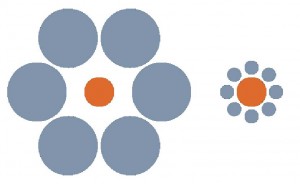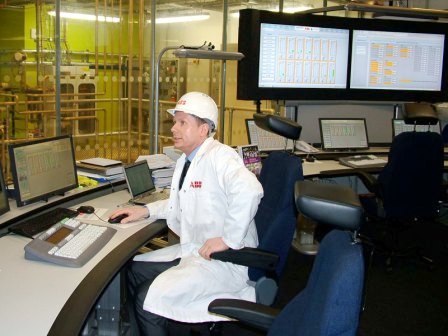The Ebbinghaus Illusion is frequently used in TV and printed media advertising. DFS, a UK furniture store, was told by the Advertising Standards Authority (ASA) to withdraw their advertisement from TV broadcast because of the false impression it gave to the viewers about the true size of a sofa. DFS, using green screen technology, manipulated the size of actors superimposed into the advertising video which made the sofas placed next to the actors look larger than they really were (BBC 2008). Interventions by ASA on the grounds of an illegitimate use of Ebbinghaus Illusion in advertising are rare. Generally, advertisers will get away with similarly blatant manipulation of product size for marketing purposes.
The use of the Ebbinghaus Illusion is not limited to marketing only. The value of money is subject to it too. The perceived value of money is determined by the comparison between the subject (money) and memory (anchor) or context in which a valuation takes place. Marketers can change the perceived value of money by influencing the context in which the valuation takes place. For example: A pair of jeans priced at £75 may seem expensive if sold in suburban areas of London. The same pair of jeans might seem cheap if found in shops in London’s Kensington.
Intertemporal Choice
Intertemporal pricing is the right pricing strategy for goods and services of high monetary value. This is due to people’s diminished ability to judge the true cost to them of purchase if payments for the purchase are spread across longer period of time. By multiplying the number of payments for the product over time, companies usually benefit from people’s reduced aptitude to compare the price they pay with alternatives. The notion of Intertemporal Choice has its roots in the Affect and Cognition branch of Psychology. Human minds are basically structured on two systems:
- Basic – spontaneous and rapid (animals and people)
- Rational – cognitive (only people)
So how does it work?
If we are already engaged in a cognitive process (thinking) at one moment in time, our ability to engage another cognitive process dedicated to another task is diminished. In a circumstance where we have to make two important decisions at once, our mind, in order to process those two decisions, will refer one to the basic system (spontaneous and rapid) and as a result the resulting decision is likely to be less rational. Marketers take advantage of Intertemporal Choice in involvement, affective and informational advertising.
Reference
- Maciejovsky, B., 2012. Ebbinghaus Illusion, Consumer Behaviour. Imperial College London, unpublished.
- BBC NEWS | Business | Advert banned for inflated sofas. 2008. BBC NEWS | Business | Advert banned for inflated sofas. [ONLINE] Available at: http://news.bbc.co.uk/1/hi/business/7762337.stm. [Accessed 12 November 2012].
Written by Michael Pawlicki


Speak Your Mind